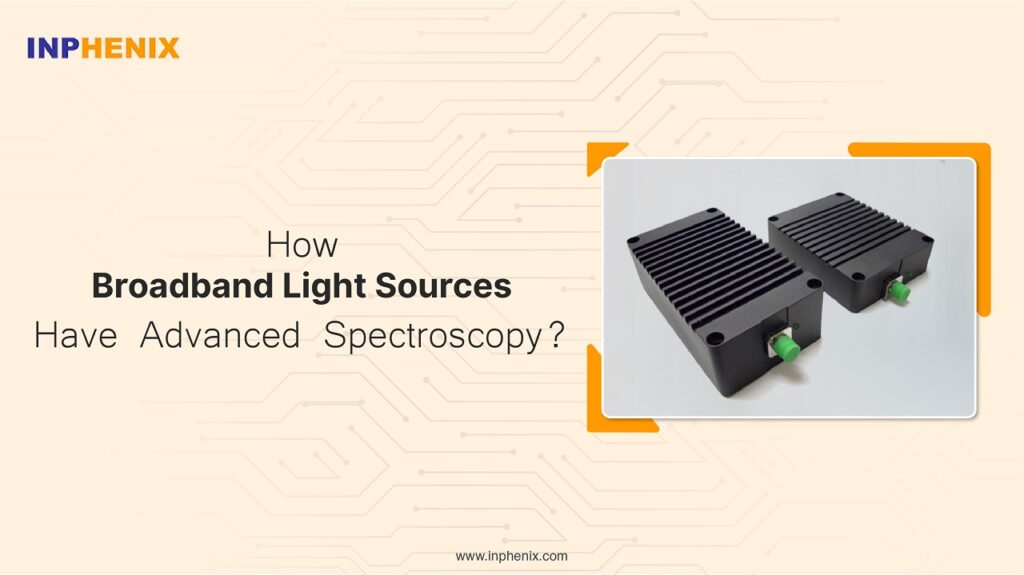
Throughout recent times, the only effective source for spectroscopy was discharge lamps, dye lasers, and optical parametric oscillators. Supercontinuum lasers, sensor plasma sources, and light-emitting diodes are a few examples of new Broadband Light Sources that are now accessible. We examine the potential of these choices for spectroscopic.
Since spectroscopic systems depend on light sources, new broadband light sources present spectroscopists with fresh prospects. For most of the previous century, only broadband light sources were accessible.
A new generation of rather robust broadband light sources, however, is gradually taking over the spectroscopist’s toolkit. Superluminescent diodes, also known as SLEDs, have now replaced supercontinuum lasers, plasma sources powered by lasers and other laser-driven devices in spectroscopic applications.
However, a new crop of sources that are comparatively tough is now gaining a place in the spectroscopist’s toolbox. Spectroscopic applications include supercontinuum lasers, laser-driven plasma sources, and high brightness LEDs in a variety of colors. Let’s discuss each of them quickly.

When a laser pulse’s frequency spectrum is widened by one or more nonlinear processes, a supercontinuum is created. When one or more spatial processes widen an electron beam’s frequency range, a supercontinuum is produced. The mechanisms underpinning supercontinuum creation are varied and complicated, depending on the medium in which the phenomenon takes place.
Depending on the medium in which the effect is taking place, several complicated mechanisms are involved in supercontinuum formation. In fiber, a spectrally wide pump beam may be used to create a supercontinuum to the red of the pump beam thanks to the interaction of stimulated Raman scattering and soliton effects.
These broadband light sources are comparable to lasers made from broadband lamps. The capabilities of these devices are used in spectroscopy in a number of ways, including the creation of innovative optical coherence tomography, visible cavity-enhanced spectroscopy, and mid-infrared absorption spectroscopy setups.
The single-mode beam quality, laser-like aiming stability, and great brightness of the supercontinuum light sources are their distinguishing characteristics. These sources resemble lasered broadband lights.
Although laser plasmas have been employed in the past as broadband light sources for spectroscopy, analytical spectroscopy has often found them to be ineffective due to their instability or weakness.
The spectroscopy from near-infrared to ultraviolet wavelengths is improved by this unique light source. Laser-driven broadband light sources have made major advancements in UV, as predicted by the reference study. For instance, UV microscopy has made it feasible to analyze biomolecules’ spectra quantitatively. The UV wavelength enables sub-cellular spatial resolution.
The method used by Energetic involves concentrating a continuous wave (CW) laser within a lightbulb that is inflated with a noble gas, such as xenon. The electrodes in a conventional lamp serve as a heat sink, keeping the lamp’s temperature in check. In addition, the electrodes continually deteriorate and spray electrical contact onto the lamp’s surface while it is in use, necessitating regular bulb changes.
The spectroscopy from the near-IR to the UV is being improved by these special Broadband Light Sources. For instance, scattering-type scanning near-field optical microscopy is frequently employed to investigate chemical compositions or nanoscale photonic phenomena. This is several orders of magnitude below the diffraction limit when using infrared light. However, the use of s-SNOM has been constrained by the scarcity of reasonably priced broadband infrared sources, as Wagner and colleagues noted in recent research.
Superluminescent light-emitting diodes also know as SLEDs, which have just lately been accessible across a large spectral range, are the most modern broadband light sources. Finding high-power, high-efficiency LEDs and color combinations that are pleasing to the eye has been the major challenge with commercial LED lighting.
In spectroscopy, the problem is different. Optimally, tunable sources are preferred, with high spectral purity or repeatability, and high stability. Regarding performance stability as a function of temperature, LEDs present a special problem. It has been a specific goal and difficulty to access electronic transitions of ecologically relevant gas molecules with UV sources.
Broadband light sources, conventional plasmas, globals, and the Sun are no longer the only sources of broadband radiation. Successful spectroscopic applications, ranging from microscopy to gas sensing and from industrial to biological applications, are increasingly utilizing a variety of novel, high brightness sources.
Inphenix is a laser and light source manufacturer based in the United States that manufactures a variety of products such as O-band optical amplifiers, distributed feedback lasers, broadband light sources, VCSELs, and swept-source lasers. Contact us to find out more about our high-quality products.
